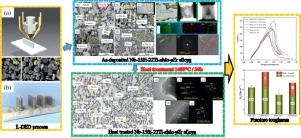Journal of Materials Science & Technology ( IF 11.2 ) Pub Date : 2021-08-26 , DOI: 10.1016/j.jmst.2021.06.027 Yunlong Li 1, 2 , Xin Lin 1, 2 , Yunlong Hu 1, 2 , Jun Yu 1, 2 , Junguo Zhao 3 , Hongbiao Dong 3 , Weidong Huang 1, 2

|
The synergistic effect of Mo and Zr additions on microstructure evolution, room-temperature fracture toughness and microhardness of Nb-22Ti-15Si-xMo-yZr (x = 4,8, y = 3,6) alloys manufactured by laser directed energy deposited (L-DED) have been investigated. The major phases in as-deposited 4Mo-3Zr alloy are Nb solid solution (Nbss), Nb3Si and γ-Nb5Si3. The Nb3Si phases disappear with increasing Mo content to 8 at.% or increasing Zr content to 6%. γ-Nb5Si3 precipitates formed in the Nbss of as-deposited xMo-yZr alloys due to the cyclic re-heating, and the γ-Nb5Si3 precipitates and Nbss matrix exhibits orientation relationship (OR) of [001]Nbss//[112]γ and (110)Nbss//(010)γ in as-deposited 4Mo-6Zr alloy. The microstructure of xMo-yZr alloys became relative homogeneity and the Nbss matrix showed the better continuity after the heat treatment (1400 °C/30 h). The Nb3Si phase has transformed into Nbss and α-Nb5Si3 with the OR have been determined as {100}Nbss//{100}α and{111}Nbss//{111}α in the heat-treated 4Mo-3Zr alloy. When Mo content increase to 8at.%, a part of γ-Nb5Si3 phase also transformed into the α-Nb5Si3 phase with the OR have been determined as {110}γ//{110}α and {100}γ//{111}α after heat treatment. Among the as-deposited alloys, the 4Mo-6Zr alloy has the highest fracture toughness KQ with the lowest hardness. The average KQ of 4Mo-6Zr and 8Mo-6Zr alloys increased by 28% and 30% after the heat treatment, and reached 13.61 and 11.43 MPa•m1/2, respectively. The hardness of Nb-22Ti-15Si-xMo-yZr alloys is significantly decreased after the heat treatment.
中文翻译:

Mo和Zr添加对激光定向能量沉积增材制造的Nb-Ti-Si基合金组织和力学性能的协同效应
Mo和Zr添加对激光定向能制备的Nb-22Ti-15Si- x Mo- y Zr ( x = 4,8, y = 3,6 )合金显微组织演变、室温断裂韧性和显微硬度的协同作用已研究沉积(L-DED)。沉积态4Mo-3Zr合金的主要相是Nb固溶体(Nbss)、Nb 3 Si和γ-Nb 5 Si 3。随着Mo含量增加到8at.%或Zr含量增加到6% ,Nb 3 Si相消失。γ-Nb 5 Si 3析出物在沉积态x Mo- y的 Nbss 中形成Zr合金由于循环再加热,γ-Nb 5 Si 3析出物和Nbss基体呈现[001] Nbss //[[112] γ和 (110) Nbss //(010)沉积态 4Mo-6Zr 合金中的γ。x Mo- y Zr 合金的显微组织变得相对均匀,Nbss 基体在热处理后(1400 °C/30 h)表现出更好的连续性。Nb 3 Si 相已转变为 Nbss 和 α-Nb 5 Si 3与 OR 已确定为 {100} Nbss //{100} α和{111} Nbss //{111} α在热处理的 4Mo -3Zr合金。当Mo含量增加到8at.%时,一部分γ-Nb 5 Si 3相也转变为α-Nb 5 Si 3 与 OR 的相位已确定为 {110} γ //{110} α和 {100} γ //{111}热处理后的α。间所沉积的合金中,4Mo-6Zr合金具有最高的断裂韧性ķ Q具有最低硬度。热处理后4Mo-6Zr和8Mo-6Zr合金的平均K Q分别提高了28%和30% ,分别达到13.61和11.43 MPa•m 1/2。Nb-22Ti-15Si- x Mo - y Zr 合金的硬度在热处理后显着降低。











































 京公网安备 11010802027423号
京公网安备 11010802027423号